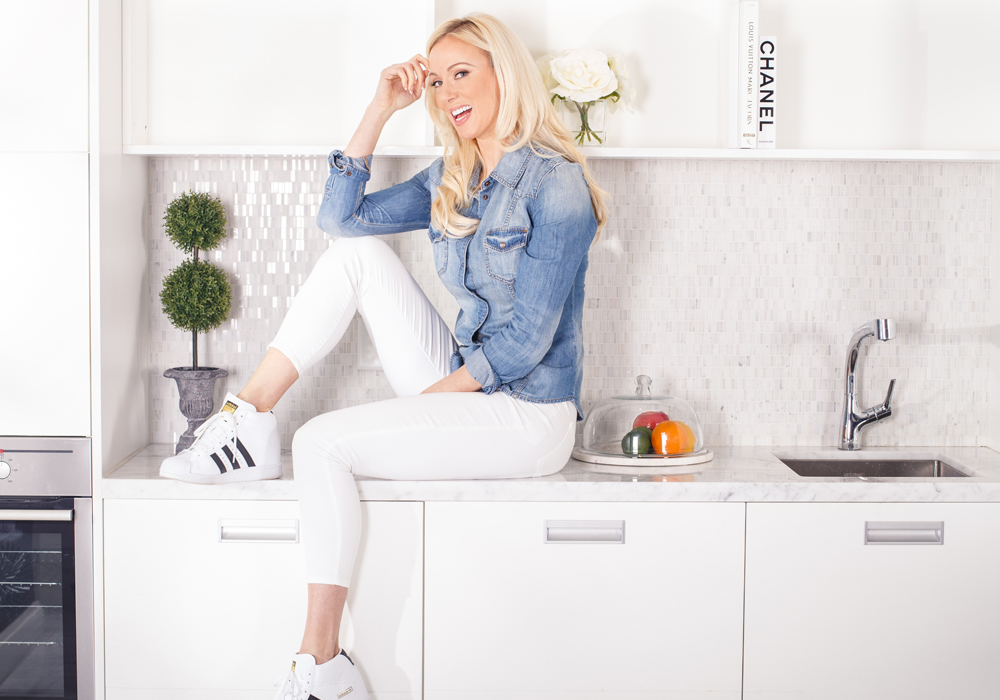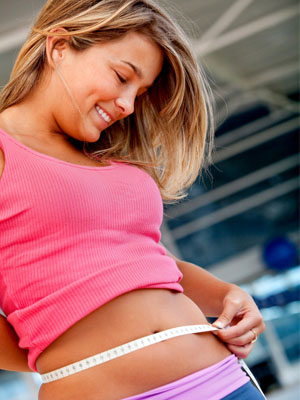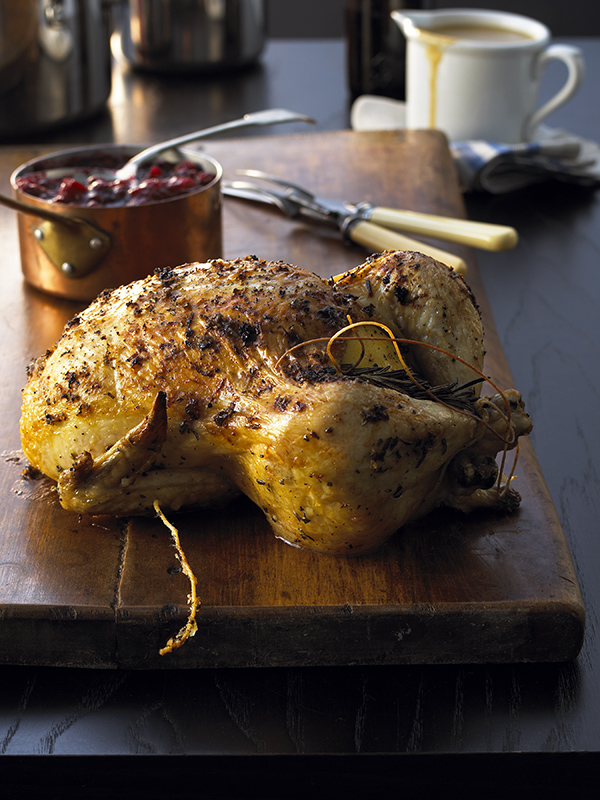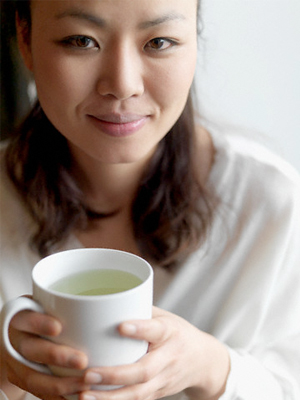England-born and Canadian-bred celebrity trainer and wellness expert Kirsty Dunne has been busy. Between her celebrity clients (hi, Mario Lopez), launching her OTG3 cold-pressed juice line and now releasing her 21 Day Metabolic Shape Up ebook (available online June 1), it’s hard to think of how she keeps it all going and keeps her energy up. We caught up with Dunne to ask her some questions about some of her favourite fitness moves, our biggest wellness mistakes and what’s next for the fitness guru.
29Secrets: How did you get started as a trainer?
Kirsty Dunne: Wanting to be healthy and fit was always something that had been built into my DNA so I just started educating myself and wanted to become my own guinea pig to understand how nutrition and health affect performance. Through word of mouth and starting off with a base clientele, my method and the way that I connect with clients, I started working with professional athletes, including the L.A. Lakers. I traveled to LA and worked with Mario Lopez on a new training book. I also got the chance to meet one of my fitness icons, the founder of Zumba.
Did you know from a young age that this was something you wanted to do?
I didn’t know this would be a career route, I was just such a passion for me and it just came so natural. I was trying to figure out what I wanted to do with my career and I realized I was pretty much already living and breathing that career and just became inspired to continue and study and work with such a range of clientele. For me, the art of working with clients isn’t necessarily a program, but about trying to identify their lifestyle and make a plan that’s realistic for them.
At what point did you decide to expand your business from working with clients to building the program?
I think through the traveling. I started at a health club at a really young age and it became quite a demand for me to work with clients one-on-one. I think the juices are an extension of everything that I’ve ever done by helping people come up with a healthy solution because we all have busy lifestyles. My mantra is “it begins from within” and I think the juices are true to that. My stepfather passed away from cancer at the age of 50 and he wasn’t healthy, which inspired me to research more about alkalizing the body with the health benefits of juicing. One thing led to another and I decided I wanted to bring this to Canada and impact other people by supplementing their diet with plant enzymes and alkalized food because we have such busy lifestyles and most of us can’t consume that many healthy fruits and vegetables a day.
What are some of your goal-setting tips to maximize success?
The steps to actually help them achieve their goals and maintain them is to identify areas in their life. As opposed to just saying this is my method, we dig deep into their lifestyle and where they are and where they’d like to be. I think the most important thing to helping clients achieve their goals and really maintain them is finding something that they enjoy doing and being active at. Identifying foods that they enjoy, but in a healthier way. That’s more in-depth strategizing than having a plan off an infomercial. It’s really making the success long-term and finding that emotional connection that inspires them and having them focus on their wellness first because that’s more of an emotional connection to why they’re doing what they’re doing as opposed to just esthetic.
How do you help clients bridge the gap between the love of self and being healthy?
Things have changed so much in that area. It’s about women feeling strong and embracing our bodies and curves. I always avoid numbers on a scale and measure performance, because it’s about how your body feels.
How do you measure fitness goals?
My method is based on performance, so cardiovascular health, heart rates, target training. Measuring your fitness goals in terms of performance instead of numbers on a scale is much more rewarding and when you see those results it pushes you harder.
What are some tips for people having a hard time staying motivated?
In the ebook, I talk a lot about that. It’s not just a nutrition or fitness plan that you follow because I don’t believe in dieting. It’s what works for you and it’s about nutrition and healthy eating, but this ebook really talks about how to reprogram your mind from dieting to healthy eating and doing works for you. It’s the same with workouts: As opposed to just saying I have to go for a workout, it helps to reprogram your mind to being active more regularly and doing activities you enjoy.
A lot of people have the mentality that they’re not working out unless they’re miserable, so how do you help people find activities that will give them results and they like doing?
I get them to identify what they enjoy doing and based on my knowledge we can create a plan that we know they’re going to see results if they’re consistent”consistency is really important. We take the gym out of the equation because it’s not the only tool to help you get fit. I try to help people switch their focus, giving them a performance goal to work towards, whether they want to do a charity walk or run and making them see that they’re capable and they can train for something. Getting them out of that comfort zone.
How do you recommend that people work fitness into their lifestyle?
I think when I help them realize that they come first, it’s a lot easier. You don’t necessarily need to work out for an hour or 45 minutes or do an intense workout; it’s more about the quality of what you’re doing or the quality of activity. We map out where there’s a gap in their day or where they can be active like maybe they can ride their bike or walk to work. Life happens and things happen, so it’s important not to stress about it and self-sabotage. Scheduling time in your week can be helpful, but we have to figure out all the areas and it’s not about feeling like you’re depriving yourself of food”it’s about changing lifestyle habits as opposed to doing something unrealistic. The enjoyment factor is really important.
It’s crazy how we create this whole internal dialogue about what we eat. How do you balance all of that without feeling deprived?
We hear a lot about cheat days, and I’m not really a believer in that. I think we can have healthier foods and there are ways to prepare those foods and make them healthier. Right now with my ebook, it talks about and gives you all these examples of meals that aren’t considered healthy and tweaks them so that you can enjoy them and have them in your everyday life. It’s to help reset your palate as well. If you’re in a situation where there’s something you enjoy eating as a guilty pleasure, have it and don’t feel guilty or self-sabotage. As long as 80 per cent of the time you’re being healthy and eating clean, if you’re working out and active, it’s not something you have to feel bad because you’re balanced. When you worry about counting calories and dieting, you put the stress on your body because you’re increasing your cortisol levels and then you put on weight because you’re stressed. It’s about having that balance and more so than anything, more people need tips on how to make healthier foods. That’s what I love about being active too because you know once in a while you can have that and not feel guilty.
What are some of the things that you will not eat?
For me, it’s all about health. I try to avoid packaged foods that have a long list of ingredients or has synthetic chemicals. If it says non-fat, fat-free or sugar-free there’s all this added sugar and sweeteners that are synthetic chemicals and your body doesn’t know how to metabolize that. That’s not healthy to me. Anything that I feel I’m not getting natural enzymes from and I know that my body isn’t breaking anything down or absorbing any nutrients, I try to avoid.
What is one of your favourite foods?
I love vegan coconut bacon. It’s amazing. It’s made with coconut and it’s smoked and it’s absolutely delicious. These are the things that once you become aware of those healthier choices, you start craving them like they are unhealthy foods because they’re so good.
What are some post-exercise tips?
After working out, I always recommend taking protein. I’ve actually switched over to a more vegan plant-based protein because while protein is great to help build the muscle tissue, plant enzymes are going to help bring your body back into a state of balance. I find that getting more nutrition in your post-workout is just as important as getting the protein.
How much protein do women generally need?
If they’re very active, about two grams of protein per kilogram of body weight. On average, about 80 grams of protein a day, but that’s if she’s really active. That doesn’t just mean meat proteins, but it could be combining proteins like beans, legumes, tofu and things like that as well, which are just as efficient.
What is your favourite workout or workout style?
My favourite is cross training”I like to do various styles of workouts and that’s what I incorporate into my method of training. I came up with a compressed version that gives a more functional effect on my body. I can run, cycle, do all the things that make me feel strong and balanced. I do Pilates, yoga, band training so that I don’t have to be at the gym and can be anywhere. A 20-minute workout of just compressed styles of using a method of explosive cardio drills so that I’m getting that cardio as well.
Will that help build cardio endurance as well?
Absolutely. I’ve done a few half-marathons and cycling races and I didn’t train”I didn’t get out there and put in 20 km a few times a week. When you train your body efficiently and you’re doing explosive cardio drills, it makes you a lot stronger and more fit and able to do longer distances. I do see a lot of clients who see better results than when they’re telling me they’re doing 45 minutes cardio at a slower pace five or six days a week. That’s great for your heart, but it’s also great to break that up into 20-second drills. I find that’s where I start to shed and notice that with my clients as well”when they do a few drills in their workouts and do that in their workouts a few times a week, you see them get leaner and stronger and see the weight come off in the waistline and problem areas.
What are some of the things that you do to unwind?
I have my routines and workouts, but I also just like to go for a nice walk or go on vacation. On vacation, we didn’t go to the gym at all. For me, it’s about creating a balance that enables me to do those other activities to ease my mind, even if it’s just biking down the lakefront.











